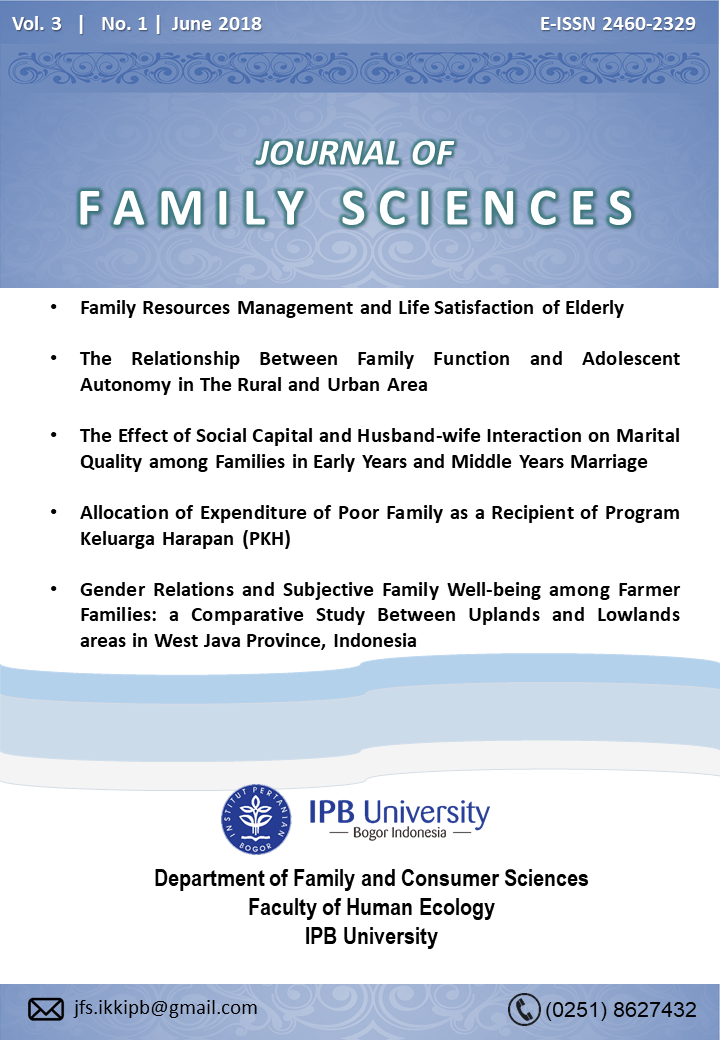The Effect of Social Capital and Husband-wife Interaction on Marital Quality among Families in Early Years and Middle Years Marriage
Abstract
This study aims to analyze the effect of social capital and husband-wife interaction on marital quality among families in early years and middle years marriage. The study was using cross sectional design. The selection of research sites was purposively chosen in Bogor City. The location of the study was in Kebon Pedes and Kedung Badak, regions of Tanah Sareal district. Samples of this study were 120 families in early and middle years of marriage with wives as the main participants. Data were collected through interview using questionnaire. The study found that social capital in families with early marriage age in the intermediate category, and in families with middle years of marriage is in the high category. Different test results show only in the dimensions of gender partnerships that families in middle years of marriage were higher than early years families. On variable of husband-wife interaction, half of the families with early marriage years were in the intermediate category and more than half of families with middle years of marriage were in the high category. There wereno significant differences in all dimensions of husband and wife interaction. In the variable quality of marriage, half of families with early years marriage were in the intermediate category, whereas more than half of families with middle years marriage were in high category. There wereno significant differences in all dimensions of marital quality.
Downloads
References
Amato, P. R., Booth, A. (1995). Changes in gender role attitudes and perceived maritalquality. American Sociological Review, 60, 58–66.
Bowen, G. L., Martin, J. M., Mancini, J. A., Nelson, P. J. (2000). Community
Capacity:Antecedents and Consequences. Journal of Community Practice,
Vol. 8(2) 2000.
Bowman, S. W. (2016).Who and What You Know: Social and Human Capital in
BlackMiddle-Class Economic Decision-Making. Race and Social
Problems (2016) 8:93-102.doi:10.1007/s12552-016-9169-6
Brinig, M. F. (2011). Belonging and Trust: Divorce and Social Capital. Faculty
Scholarship. Notre Dame Law School.
Canel, A. N. (2013). The Development Of The MaritalSatisfaction Scale
(MSS).Educational Sciences: Theory & Practice 13(1)Winter97-117.
Educational Consultancy and Research Center. Marmara University.
Carrere, S., Buehlman, K. T., Gottman, J. M., Coan, J. A.,Ruckstuhl, L. (2000).
Predicting Marital Stability and Divorce in Newlywed Couples.Journal of
Family Psychology, 14(1), 42-58.
Cooke, L.P., Erola, J., Evertsson, M., Gähler, M., Härkönen, J., Hewitt, B.,
Jalovaara, M., Kan, M.-Y., Lyngstad, T.H., Mencarini, L., Mignot, J.-F.,
Mortelmans, D., Poortman, A.-R., Schmitt, C., and Trappe, H. (2013).
Labor and Love: Wives' Employment and Divorce Risk in its SocioPolitical
Context.
Social
Politics:
International
Studies
in
Gender,
State
&
Society
(4):
-509.
Cote, S dan Healy, T. (2001). The Well-Being of Nations. The Role of Human And
Social Capital. Paris: Organizationfor Economic Cooperation and
Development.
Cutrona, C. E. (1996).Social Support as a Determinant of Marital Quality.
Handbook of Social Support and the Family pp 173-194.
Fincham, F. D., Rogge, R. (2010). Understanding Relationship Quality:
TheoreticalChallenges and New Tools for Assessment.Journal of Family
Theory & Review 2(December 2010): 227–242 227.doi:10.1111/j.17562589.2010.00059.x
Fowers, B. J.,Olson, D. H. (1993). ENRICH Marital Satisfaction Scale: A Brief
Research and Clinical Tool. Journal of Family Psychology 1993, Vol. 7,
No. 2, 176-185.
Furman, W., Buhrmester, D. (2009).The Network of Relationships Inventory:
Behavioral SystemsVersion. International Journal of Behavioral
Development. 2009 September 1; 33(5): 470–
doi:10.1177/0165025409342634.
Gottman, J. (2002). The Seven Principles for Making Marriage Work.Three
Rivers Press: Crown Publishing Group: New York.
Gudmunson, C. G., Beutler, I. F., Israelsen.C. L., McCoy, J. K. E., Hill, J. (2017).
Linking Financial Strain to Marital Instability: Examining the Roles of
Emotional Distress and Marital Interaction. Journal of Family Economic
Issues(2017) 28:357–376.doi:10.1007/s10834-007-9074-7
Hall, S. S.,Adams, R. A. (2011). Newlyweds’ unexpected adjustments tomarriage.
Family and Consumer Sciences Research Journal, 39, 375-387.
Holmes, J.G., Rempel, J.K. (1985). Trust in close relationships. In C. Hendrick
(Ed.), Close relationships:Review of personality and social psychology
(Vol. 10, pp. 187-220). Newbury Park, CA: Sage Publications.
Joseph, S., Inbanathan, A. (2016).A Sociological Review ofMarital Quality
amongWorking Couples inBangalore City. The Institute for Social and
EconomicChange. Bangalore
Kulu, H. (2014). Marriage Duration and Divorce: The Seven-Year Itchor a
Lifelong Itch?Population Association of America 2014 Demography
(2014). 51:881–893 doi.10.1007/s13524-013-0278-1
Kreider, R. M., Ellis, R. (2011). Number, Timing, and Duration ofMarriages and
Divorces.Household Economic Studies.
Larson, J. H., Anderson, S. M., Holman, T. B., Niemann, B. K.(1998). A
longitudinal study of the effects of premarital communication, relationship
stability, and self-esteem on sexual satisfaction in the first year of
marriage.Journal of Sex & Marital Therapy 1998 Jul-Sep;24(3):193-206.
DOI: 10.1080/00926239808404933
Ledermann, T., Bodenmann, G., Rudaz, M., Bradbury, T. N.(2010). Stress,
Communication, and Marital Quality in Couples. Family Relations 59
(April 2010): 195 – 206 195. doi:10.1111/j.1741-3729.2010.00595.x
Levenson, R. W., Carstensen, L. L., Gottman, J. M. (1995). Emotional Behavior
in Long-Term Marriage. Psychology and Aging1995. Vol. 10. No. I. 140149.
Locke, H.J. dan Wallace, K. M. (1959). Short Marital Adjustment And Prediction
Tests: Their Reliability And Validity. Marriage and Family Living, 21,
–255.
Nasution, A., Rustiadi E., Juanda B; HadiS. (2015).Two-Way Causality between
Social Capital and Poverty in RuralIndonesia.Asian Social Science; Vol.
, No. 13; 2015
Rosen-Grandon, J. R., Myers,J.E., Hattie, J. A. (2004). The relationship between
marital characteristics, marital interaction processes, and marital
satisfaction. Journal of Counseling and Development : JCD; Winter 2004;
, 1; ProQuestpg. 58
SadeghiMS, MazaheriMA, Motabi DF, Zahedi K. (2012). Marital interaction in
iranian couples: examining the role of culture. Journal of Comparative
Family Studies 43.2 (2012): 281-XVII.Shahid Beheshti University (GC):
Iran.
Schmitt, M. (2007). Marital interaction in middle and old age:a predictor of
marital satisfaction?Int’l. J. Aging and Human Development,Vol. 65(4)
-300, 2007.Baywood Publishing: New York.
Sztaudynger, J.J. (2014). Family Social Capital, Marriage and Fertility. Folia
Oeconomica Stetinensia.doi: 10.1515/foli-2015-0009.
Spanier, G. B. (1976). Measuring Dyadic Adjustment: New scales for Assessing
The Quality of Marriage and Similar Dyads.Journal of Marriage and
Family, 38(1), 15- 28.
Authors who publish with this journal agree to the following terms:
- Authors retain copyright and grant the journal right of first publication with the work simultaneously licensed under a Creative Commons Attribution 4.0 International License that allows others to share the work with an acknowledgement of the work's authorship and initial publication in this journal.
- Authors are able to enter into separate, additional contractual arrangements for the non-exclusive distribution of the journal's published version of the work (e.g., post it to an institutional repository or publish it in a book), with an acknowledgement of its initial publication in this journal.
- Authors are permitted and encouraged to post their work online (e.g., in institutional repositories or on their website) prior to and during the submission process, as it can lead to productive exchanges, as well as earlier and greater citation of published work (See The Effect of Open Access).



_001.png)



